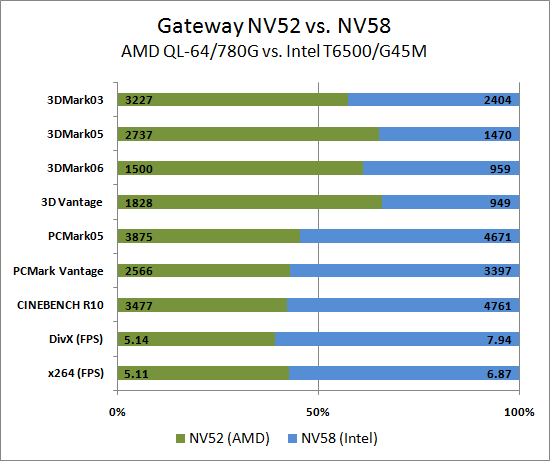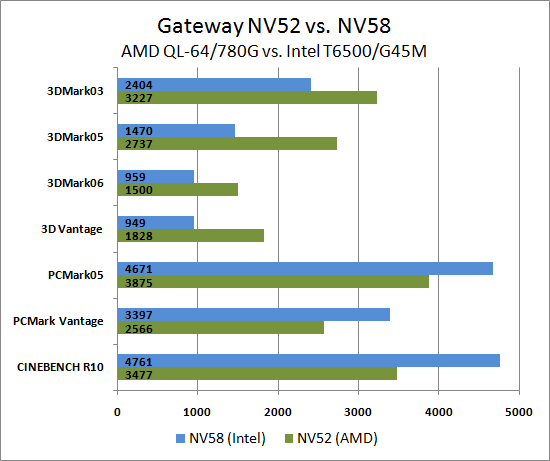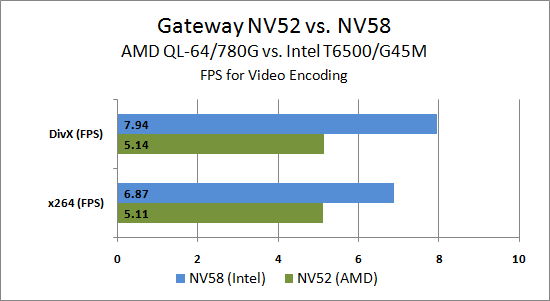Gateway AMD and Intel Laptops, a Platform Analysis
by Jarred Walton on August 12, 2009 2:00 AM EST- Posted in
- Laptops
Application Performance - AMD vs. Intel
Next up is an overview of application performance. We've already hinted that Intel wins handily when it comes to general performance, and this should come as no surprise. After all, the Intel juggernaut has been on a rampage ever since the launch of Core 2 Duo back in 2006. (Has it really been that long? Yup.) At the time Core 2 Duo launched, clock for clock (E6600 vs. 4600+ at 2.40GHz) Intel's Core 2 Duo was 10% to 50% faster than AMD's Athlon X2, with the average being somewhere around 20% faster. Three years and a switch to mobile platforms and smaller process technology doesn't radically alter the picture, although updated benchmarks and software that are more multi-core friendly tend to favor Intel even more.
Here's a look at various applications, including 3DMark and PCMark composite scores. We will have a closer look at the PCMark scores on the next page. As for 3DMark, while the CPU scores in the various iterations favor Intel (14% in 3DMark03, 17% in 3DMark05, and 23% in 3DMark06), the overall performance scores give a taste of things to come when we look at graphics performance.

The results aren't very surprising if you've been following the processor and graphics markets for the past couple years. The Intel laptop is clearly faster in applications that depend primarily upon the CPU: 34% faster in x264, 25% faster in DivX, 37% faster in CINEBENCH, 21% faster in PCMark05, and 32% faster in PCMark Vantage. Switch to the graphics intensive 3DMark and the tables turn. The AMD platform is 34% faster in 3DMark03, 86% faster in 3DMark05, 56% faster in 3DMark06, and 93% faster in 3DMark Vantage. Note that we used the "Entry" setting for 3DMark Vantage, and we had to use an external LCD in order to run at the standard resolutions in 3DMark06 and 3DMark Vantage. It's also worth mentioning that the Intel system consistently failed to run 3DMark Vantage at the "Performance" defaults.
The above results are good indication of performance in specific tasks, but PCMark tends to obfuscate the picture by combining many tests into one composite score. Let's have a closer look at the PCMark results, as they can be quite informative.
Update
Again, here are alternate graphs showing the same data as the above chart. Note that we had to split out some of the results to make the charts readable (i.e. the low FPS values for video encoding don't work with the other results; that's why we chose the "100% Stacked Bar" chart in the first place).












67 Comments
View All Comments
7Enigma - Wednesday, August 12, 2009 - link
Agreed. People are not going to be gaming on the latest (or even last-gen FPS') but most certainly would probably be doing MMO games. And of all the games The Sims (2 or 3) should be included. That is probably the largest non-MMO game out there for the casual gamer, of which these laptops are perfectly suited.KidneyBean - Wednesday, August 12, 2009 - link
Or how about Source games like Half-Life 2, Team Fortress 2, and Counter-Strike 2?Those should run faster than the latest FPS.
hyc - Wednesday, August 12, 2009 - link
Very few vendors actually sell comparable models of AMD and Intel notebooks. I don't think HP's dv5z (which I own, and is already discontinued) is really comparable to their dv5t.And I've yet to find anyone selling an AMD laptop with 15.4" WUXGA screen. So far the only possibilities have been Dell or Lenovo, and they're all Intel. It's pathetic that AMD has the best graphics cards now but you can't get an AMD combo paired with the best screens.
Show me an AMD notebook with 15.4" WUXGA LED-backlit screen. (Oh, and backlit keyboard too, please.) I'll buy it. I'm sick of seeing AMD designs getting the poor cousin treatment, I want all the same top notch feature choices the Intel models get...
strikeback03 - Thursday, August 13, 2009 - link
You realize you can get an AMD discrete GPU with an Intel CPU/chipset, right? Which this article has shown that the GPU is really the only part of the AMD system worth owning.cactusdog - Wednesday, August 12, 2009 - link
Nice review, it answered some questions i had.cfaalm - Wednesday, August 12, 2009 - link
Talking about a price premium over a $ 500 - 580 notebook:
damianrobertjones - Wednesday, August 12, 2009 - link
Or if Dailytech really isn't one sided towards Apple, then maybe the reviewer could also add a Linux build to the scene.. Standard laptop, linux.. what would the battery life be?????hyc - Wednesday, August 12, 2009 - link
Likely worse on the AMD system. At least, the open source ATI drivers' support for power management still doesn't handle all of the power save features that the chipset offers.medi01 - Wednesday, August 12, 2009 - link
Why not compare to intel notebook with nvidia graphic card?samspqr - Wednesday, August 12, 2009 - link
the labels on the x axis of the power consumption graph are completely deceiving